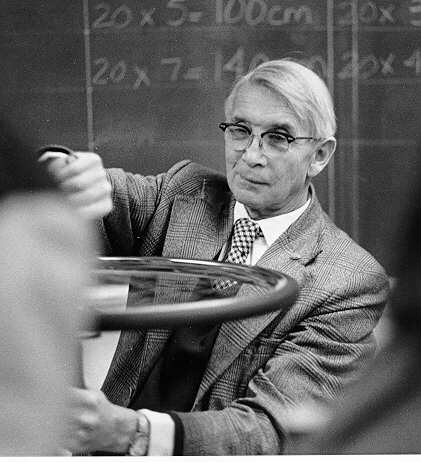
BIOGRAPHY OF ERNST ISING
( 1900 - 1998 )
-
born May 10, 1900, Cologne , Germany.
died May 11, 1998, Peoria , Ill., USA.
|
|
BIOGRAPHY OF ERNST ISING
|
Ernst Ising (born May 10, 1900, Cologne, Germany – May 11, 1998, Peoria, Illinois, USA) was a German physicist, who
is best remembered for the development of the Ising model of ferromagnetism. He was a professor of physics
at Bradley University until his retirement in 1976.
Ernst Ising was born May 10, 1900 in Cologne, Germany. In 1919 he began studying mathematics and physics at the University of Gottingen, and continued his studies in Bonn and Hamburg. In Hamburg his teacher, Wilhelm Lenz , suggested to Ernst that he turn to theoretical physics and he began investigating a model of ferromagnetism which Lenz had introduced in 1920. Ernst graduated with a Ph.D. in physics from the University of Hamburg, Germany, in 1924. In his doctoral thesis he studied the special case of a linear chain of magnetic moments, which are only able to take two positions, "up" and "down," and which are coupled by interactions between nearest neighbors, a model which came to be known as the famous Ising Model.
In a short history, "Ernst Ising—Physicist and Teacher", written by S. Kobe and published in the Journal of Statistical Physics Vol. 88, August 1997 it is indicated that the name "Ising model" seems to have been coined in a publication in 1936 by R. Peierls "On Ising’s Model of Ferromagnetism." Peierls considered boundary lines which separate "up" and "down" spin regions in a two-dimensional square Ising lattice. By estimation of an upper limit for the total length of closed boundaries he could show that, at sufficiently low temperatures, only a small fraction of all spins are enclosed by boundary lines. Consequently, the majority of spins must have the opposite sign leading to spontaneous magnetization of the system. Other researchers found that Peierls summations over the lengths of boundaries were incorrectly extended to infinity for finite systems. A 1964 paper remedied this defect by a modification of Peierls’ proof. Peierls pointed out in a later paper that his original argument is not influenced by the found error, because it only leads to an overestimation of the length of boundary lines and the rest remains valid.
The most striking success of the model is accompanied by the search for the phase transition between the ferromagnetic and the paramagnetic state. The actual breakthrough came from the findings of various authors which say that a matrix representation of the problem can be introduced in such a way that the partition function can be related to the largest eigenvalue of this matrix. Kramers and Wannier calculated the numerical value for the Curie temperature of the two-dimensional Ising model, whereas the exact and complete solution was first given by Onsager.
Ernst married Johanna (Jane) Ehmer on December
23,
1930 in Berlin, Germany. He taught at public high schools in
Germany,
but was dismissed when Adolf Hitler came into power in 1933. From
1934 to 1938, he was a teacher and headmaster of a Jewish boarding
school. In Caputh, Ernst and his wife Jane found themselves
neighbors to Albert Einstein who had a summer home there. Ernst
enjoyed telling how he took his daily baths in Einstein's bathtub
because he and Jane did not have a bathtub in their home.
In November 1938, the school at Caputh was
destroyed by the Nazis and Ernst and Jane were forced to leave Germany
the following year. They fled to Luxembourg with plans to
emigrate to the US as soon as possible. When the Germans invaded
Luxembourg in 1940 and rounded up most Jews a year later, Ernst and
other men who were married to non-Jews were forced to dismantle the
Maginot Line railroad in Lorraine. For the next four years, Ernst
and Jane worked at menial jobs, struggling to survive.
They finally got to the US in 1947, and Ernst
taught physics and mathematics at the State Teachers College in Minot,
North Dakota. A year later, he came to Peoria and Bradley
University where he taught in the physics department until his
retirement in 1976.
Ernst's life was forever changed by World War
II. He never returned to his early research. In fact, it
was not until 1949 that he found out from the scientific literature
that his model had become widely known. Today, the Ising model is
a widely used standard model of statistical physics. Each year
about 800 papers are published that use the model to address problems
in such diverse fields as neural networks, protein folding, biological
membranes and social behavior.
In the postwar years, Ernst's great passion was
for teaching, at which he excelled. His students will never
forget his elaborate classroom demonstrations.
Ernst was a sensitive, artistic man who loved
travel and the arts. He had a keen mind and sharp sense of humor,
but was a gentle, quiet individual who always seemed a little shy when
questioned about his famous model.
Jane Ising continues to live in the couple's home
located close to the Bradley campus.
The Ising Conference room is located in Bradley
University's Olin Hall of Science where visitors can view framed copies
of Ising's dissertation in both German and English along with
photographs of Ernst and Jane through the years.
There are a few places where the biography of Ernst Ising can be found.
Wikipedia electronic Encyclopedia(http://en.wikipedia.org/) , an article Ernst Ising .